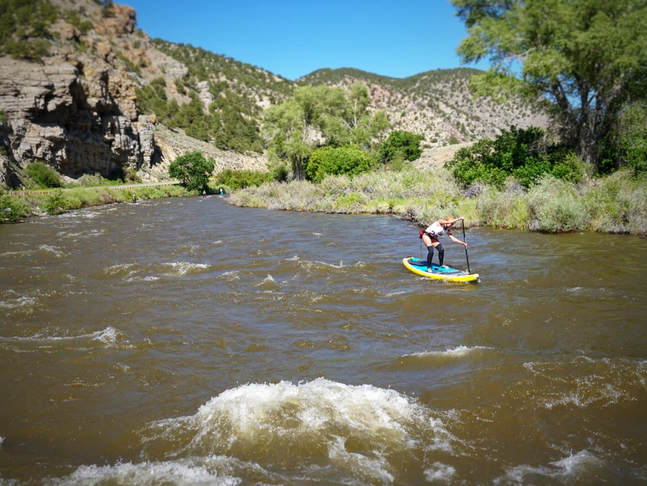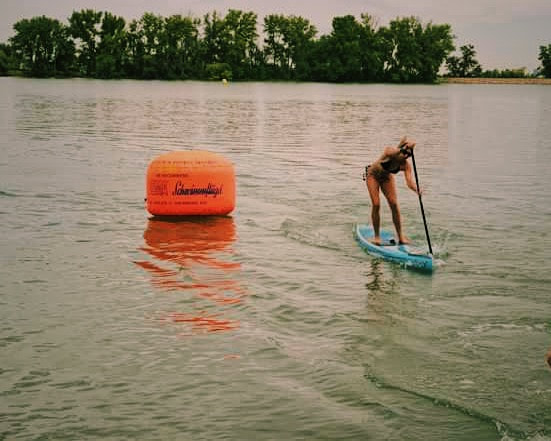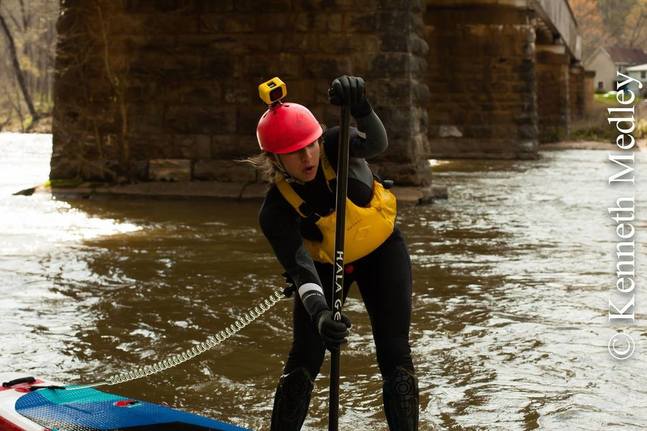"How do I get my SUP to go straight?"Photo captured by Brad Mickelson at the 2017 FibArk on the Arkansas River, Colorado. Most people can pick up paddle boarding within the first SUP session, no lesson necessary. However, there is more to stand up paddle boarding than meets the eye, and even though most people consider their SUP experience a success because they can stand and somewhat navigate their board, there are some simple tips that can improve their paddle experience. In this post, I will equip you with tools to combat the number one question I hear from SUP newbies while establishing their paddle technique -- "How do I get my SUP to go straight?" I have three tips that will help you make your paddle board go straighter. However, these three tips are only the tip of the iceberg when it comes to addressing all the factors that go into paddling a board in a straight line. It takes hundreds of thousands of paddle strokes and techique development to get the perfect paddle stroke. By implementing my three tips, you may be able to increase the paddle strokes you can throw down on one side by 5 to 10+ strokes before having to switch sides, versus switching sides you're paddling on every 3 to 4 strokes now. No more zig-zag paddling! #1. Stack your Hands. Think of your board like a rocket ship. Your goal is to go forward, so in order to do that, we must think about Newton's Third Law, "For every action, there is an equal and opposite reaction." So if our board is our rocket ship, and we want to go forward in a straight line, then we must ensure that we are pushing the water directly behind us in a straight line. The number one thing I see newbies do is push the water diagonally behind them, rather than straight behind them. A visual indicator of this is that when they are in the power/pulling phase of their stroke, the angle of the shaft of the paddle is anything but vertical. This causes the board to go diagonally in the opposite direction. Photo Captured by David Weihnacht at the 2016 Altitude SUP Classic Push the water straight back by stacking your top hand (the one on the t-grip) over your bottom hand (the hand on the shaft). Instructors use the analogy, "You should be able to drop a penny from your top hand and catch it in your bottom hand." By having your hands stacked over each other, the angle of your paddle will be completely vertical. You should be able to *loosely* use the rail of your SUP to guide your paddle blade backwards (compensate for the fact that the rails of the boards are slightly curved). If you feel like you have to do a side-crunch with your torso in order to ensure that the paddle is completely veritcal, then that is totally fine and normal! Just make sure you are keeping your shoulders are packed and protected. #2. Shorten and/or Reach in your Paddle Stroke. Paddle boards steer similar to bicycles. On a bicycle, you are responsible for steering the front wheel and the back wheel will follow. On a SUP you are responsible for directing the nose and the tail will follow because there is a fin on the back of the board. So if you are having a hard time making your board track straight, then assess the length of your paddle stroke. If you are doing long strokes covering the length of the board from nose to tail, then chances are, the board is veering off course from the time that your paddle is past your feet near the tail of your board. When you want to turn your board quickly, throwing down paddle strokes near your fin is a great strategy, but when you want to go straight, your paddle strokes should be placed starting from the top of the nose of the board and no further back than your feet, for the most part. Shorter strokes toward the front half of the SUP means that the nose of your board has less time to drift off course because you will constantly be directing the nose with your strokes. The tail will follow. It's also much better for your shoulder to paddle this way, but that's another topic for another day. #3. Look Where you Want to Go. Your line of sight says a lot about where you're going. If you look down, you fall down. If you look at the rock, you're going to hit the rock. And likewise, if you look where you want to go, then you will go that way. It's the same concept when I vault and ride horses, and it's a common practice for many sports. SUP is no different. If you look up and forward, then you are more likely to steer your board forward because you're aligning your body's torque, positioning, and weight placement. Your board tends to go where you're looking. So if your goal is to paddle in a straight line toward the buoy, lock your sights on the buoy! If you're doing a distance race, always find a landmark or something to aim for so that you don't find yourself zig-zagging off-course. Photo by American Dream: Overland Expedition at the 2016 NoliFest in Erwin, TN. Practice these tips next time you go out on a SUP! If you feel that you have it down and you are still zig-zagging, then here's some more homework:
Good luck, and happy paddling! Comment if you have any additional questions :) |
Archives
September 2019
Categories
All
|



 RSS Feed
RSS Feed